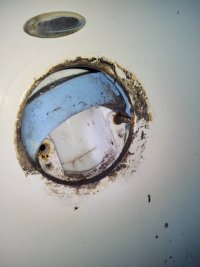Donny BeGood
New Member
I was removing the two screws that holds on a chrome overflow pipe cover for a bathtub and one of the screws has broken off. It is still attached to the screw hole in the PVC pipe. All that is left of the corroded metal screw is a small sharp point that won't come out. It is probably only about 1/8-1/4 inch long and it is pretty much impossible to grab onto it with anything. There is no access to it from the back side. Should I try to grind it down flat with a dremel type grinding bit and then try to remove it with a screw extractor? Also, the gasket looks somewhat dry and cracked (20 years old). Will that be easy to replace keeping in mind the only access will be from the overflow opening on the tub.

